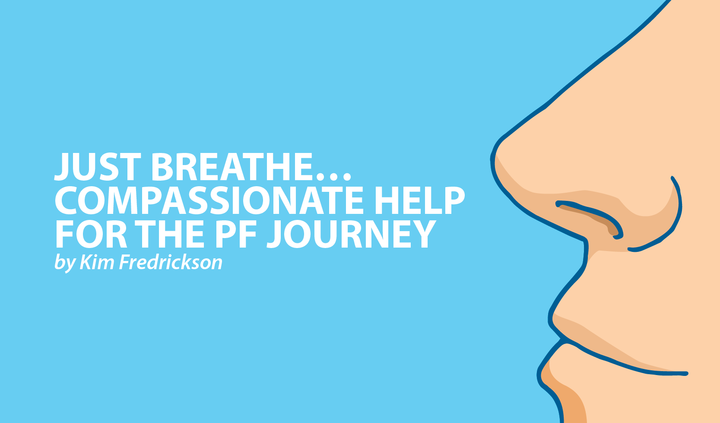Solutions for Everyday Problems We Face as PF Patients

I had the pleasure of being a patient guest on a live webinar last week, which shared information about the IPF Catalyst Challenge – a contest with a $1 million prize to come up with solutions to help PF patients.
This contest invites the brightest innovators, entrepreneurs, and healthcare thinkers to participate in upcoming solutions to address the many problems faced by patients. Applications are being accepted until Oct. 25, 2017, and the three winners will be announced in January 2018.
Don’t worry if you missed it. You can watch it here.
It was such a delight to talk with Elizabeth Estes from Three Lake Partners, a philanthropic organization set on championing medical and healthcare solutions that might not get the attention and support they so justly deserve. They chose to donate $1 million for this contest to help those with IPF because a beloved family member passed away from this disease two years ago.
I also enjoyed talking with Kathleen Lindell, PhD, a clinical nurse specialist in IPF, with the University of Pittsburg/Sammons Center, who has devoted her professional life to help patients.
During the webinar, lots of patients chimed in and shared problems they’d like these bright innovators, entrepreneurs, and healthcare professionals to solve. Here they are:
Ways to monitor and control our supplemental oxygen
One way to help control oxygen use would be to develop an app or a device that could change oxygen flow without having to get up to adjust the dial. This is needed because we usually need a different O2 level when sitting, walking, and exercising. It would be so much easier if we could monitor saturation levels, and remotely change the level of the flow from an app on our phone.
Another suggestion would be to come up with a bluetooth-enabled device like a Fitbit we could wear that monitors heart rate, O2 level, and steps. It would be especially great to be able to log a record of what we ate, weight, medication, and other factors such as humidity or temperature that can affect our ability to breathe. We could also share this important data with our physicians.
Lastly, developing a different high flow regulator could be beneficial to PF patients as well. These regulators have significant jumps dispensing liters per minute as higher levels of O2 are needed. Patients need a way to adjust liter flow by one or two levels instead of having to jump three liters at a time.
Better way of knowing how much O2 is left in our tanks
A lot of the dials on regulators and oxygen concentrators are either in a difficult place to read or are too small to read. This makes it difficult to see how much oxygen remains in the tank as well as adjust O2 flow to the correct level.
Another idea shared was to have a large glow-in-the-dark dial to see easily at night.
Early and accurate diagnosis
One challenge for patients is the length of time it takes to see an ILD/PF specialist. Community-based pulmonologists are often not experienced enough with this rare disease. Many patients shared how they were misdiagnosed for years and had to push for further testing to get an accurate diagnosis.
Kathleen Lindell said on the webinar that it takes an average of 26 months for patients to receive their diagnosis, losing valuable time for treatment that may slow the progression of this disease.
One idea shared was to develop a stethoscope that could hear the unique sounds heard by patients who have PF. This would help physicians distinguish pulmonary fibrosis from asthma, COPD, pneumonia, or other lung diseases.
Quality of life
It was so encouraging to hear patients and professionals come together to address the quality-of-life issues that we as patients experience every day. Of course, what we all want is a cure, and to not have PF. In the meantime, it is so important to raise our quality of life in any way possible!
I’d love to get your response
What is it like to know that there are organizations like Three Lakes Partners that are fighting for us, hoping to improve our quality of life? Do you have ideas you’d like these innovators to come up with, to solve everyday problems you deal with as a PF patient?
We’re in this together! Please share this post with anyone you think could benefit, or on social media.
***
Note: Pulmonary Fibrosis News is strictly a news and information website about the disease. It does not provide medical advice, diagnosis, or treatment. This content is not intended to be a substitute for professional medical advice, diagnosis, or treatment. Always seek the advice of your physician or other qualified health provider with any questions you may have regarding a medical condition. Never disregard professional medical advice or delay in seeking it because of something you have read on this website. The opinions expressed in this column are not those of Pulmonary Fibrosis News or its parent company, Bionews Services, and are intended to spark discussion about issues pertaining to pulmonary fibrosis.









Dana Callahan
Dearest Kim, Thank you so much for this interesting news! You are such a champion of we IPF patients and I appreciate everything that you share with us. God Bless You Always, Dana
P.S. Does anyone ever talk about severe joint pain with IPF? I have been experiencing horrible left hip pain, and just wondered if this can also go along with IPF or the ESBRIET drugs I take. Thank you.
Kim Fredrickson
Thanks so much Dana! I think we are all doing what we can to care for ourselves and help advance our cause as much as is possible. I appreciate your encouragement. So sorry about your joint pain. I haven't experienced this myself, and I'm not in Esbriet. I hope you get some relief!
Russ Wyckoff
I wish there were companies that make portable carry type concentrators that can supply 6 to 10 leters of oxygen.
Isabel Mickle
I totally agree that the portable oxygen compressors look amazing. But when I check into it, the liter flow is very low and it wouldn't last anytime at all for me. I am now at 5 liters or higher to do anything. It would be wonderful to have higher liters 6-10+. Traveling anywhere even to the grocery would be easier. Plus longer battery life would also help so carrying another battery as a backup wouldn't be needed. they say the batteries tend to not last too long. Plugging the system in to charge is great but it sounds like a bit more power without adding weight to carry would make traveling much more enjoyable.
Katie Bagshawe
My Father needed between levels 8 and 10 and found liquid oxygen extremely useful as traditional airflow tanks last barely any time at all. Do you know if liquid oxygen might be available to you?
Kim Fredrickson
Hi Katie, I too use liquid and it really makes a difference. I'm grateful to get it. A lot of people are not able too.
Kim Fredrickson
So agree Isabel!!!
Kim Fredrickson
Boy, me too Russ. What a difference that would make to keep us active as our needs for O2 go up.
Mary Nuzzi
someone needs to make a light weight POC that provides 6lpm and higher. I am so depressed over my new POC that weighs 22lbs and I have to pull around. It effects my ADL,s
Mary Lasowski
I watched the webinar and glad I did, hopefully we can get great help out of this.
I will try to think of things to make it better for us.
Kim Fredrickson
Thanks Mary! So glad you were able to watch and be a part of our brainstorming.
Bob Wells
Every thing identified here is spot on.
I have a question for the community, Has anyone had suggest using wi-fi plugs with oxygen concentrators? I need 6 liters when active but often none when at rest. Would be nice to ask Alexa to switch off plug.
Bob
Kim Fredrickson
Bob that's a great idea!!!
Katie Bagshawe
All are brilliant and wonderful ideas! We definitely needed a better system to monitor the amount of O2 left in a flask when out and about as there is no warning/alarm to alert when running low. I'm wholly interested in the concept of improving stethoscopes to hear more distinguished lung sounds that could improve diagnosis times as that too is severely lacking in the UK at the minute, as well as a lack of knowledge and awareness of PF.
Kim Fredrickson
Yes, those are both wonderful idea Katie. These types of improvements make such a quality of life difference to us!
Bob Wells
Kim
Tried it. The plug worked great BUT it set off a continuous alarm from the concentrator. I was afraid that would happen.
Next to try is a flow control value. One is 10 bucks so I'll try that first.
The second is called Co-Pilot. $150. Worried if anyone tried
it.
Finally China makes remote controller home concentrators. Could that somehow speed up tech advances here.
These are important challenges.
Bob
Kim Fredrickson
Hey Bob, thanks so much for trying things out and letting us know. I haven't heard of Co-Pilot. What does it do? Interesting to hear that China makes remote control concentrators...You are a fount of knowledge!!!
Bob Wells
Thanks Kim. Like you I believe if we are do our part we can
dramatically change our quality of life by bring about these needed changes in the equipment we must have in order to support it.
Co-Pilot is said to provide remote control of oxygen liter flow rate with a Precision rotameter to accurately confirm and adjust liter flow rate at patient side up to 50 feet away from oxygen system. It's made by Captive Technologies. I can only find one review and its positive.
Wonder if anyone has tried the Chinese Compressors. I plan to do more research to see if I can find a US distributor for one of them who will honor the warranty.
Perhaps we could do another Facebook video with manufacturers willing to show their products in action?
Bob
Kim Fredrickson
Hi Bob, Thanks so much for all this great info. I'm going to check out the Co-Pilot. I'm talking with someone about your idea of maybe having another webinar with manufacturers willing to share their products. I watched a webinar today about an interesting product. https://www.facebook.com/pfwarrior/videos/828020010692997/ Thanks Bob!